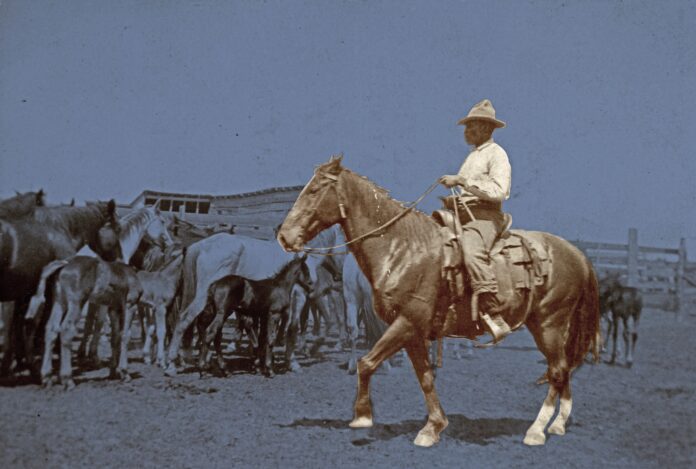
“Black Cowboys: An American Story” will open Jan. 21 at the African American Museum in Dallas. With more than 50 artifacts, photographs, documents and films, the exhibition explores the lives and work of the numerous Black men, women and children – enslaved and free – who labored on the ranches of Texas. Many participated in cattle drives before the Civil War through the turn of the 20th century.
The exhibition is free and open to the public, presented locally by Bank of America. It will run through April 15 at the African American Museum in historic Fair Park. “Black Cowboys“ is organized by the Witte Museum, and Oncor is the presenting sponsor.
Black Cowboys Offers Insight
By revealing stories that have largely been untold, “Black Cowboys” offers insight into the legendary cowboy. It gives a clearer picture of the Black West, and a more diverse portrait of the American West. Organized into three sections, the exhibition begins with the work Black cowboys performed. They tended cattle along the trails from 1865 to the 1890s, and they were integral to the Texas economy. The exhibition progresses to explore Black ranching families and the ways enslaved and free Black cowboys developed ranches of their own after Emancipation. The third section spotlights popular performances by Black cowboys in rodeos, music and film.
“The inspiring stories of these amazingly skilled Black cowboys are powerful. These men – and women – persevered and succeeded despite discrimination and overwhelming odds, many finding success through generations as ranchers and leaders in their field,” said Dr. Harry Robinson, Jr., president and CEO of the African American Museum, Dallas. “We are grateful to our Texas neighbor, the Witte Museum in San Antonio, for their remarkable work in sharing the lives and impact of the Black cowboy in such a beautiful and compelling manner and to Bank of America and all our generous supporters for helping us bring this story to light.”
Black Cowboys Helped Tame the West
Visitors will discover how Black cowboys tamed and trained horses, tended livestock and rode on the trail with thousands of cattle across America. Over time, the role of Black cowboys evolved as they used the skills they learned on the ranch and trail to own their own ranches, serve as lawmen, ride in rodeos, become singers and perform in movies. Today, the lives and legacies of Black cowboys have inspired new generations to explore the past through music, film, fashion and design.
“Black cowboys were integral to the growth of Texas’ cattle industry immediately after the Civil War,” shared Ron Davis, Ph.D. candidate of the University of Texas, who co-curated the exhibition alongside the Witte Texas History Curator Bruce Shackelford. “In fact, one in four cowboys that went up the trails was a Black cowboy.”
Hector Bazy Film
Central to the exhibition is a film about Hector Bazy, portrayed by distinguished actor and playwright Eugene Lee. Born enslaved on a plantation in Grimes County, Texas, in 1851, Bazy wrote an autobiography in 1910 describing the exhilarating and dangerous work of cowboy life. In the film, Lee speaks Bazy’s own words to describe his experiences.
“With the launch of its new exhibit, ‘Black Cowboys: An American Story,’ the African American Museum, Dallas is shining a spotlight on the influence and heritage of a unique group of trailblazing Americans. Bank of America has a deep commitment to supporting and sustaining the arts, and our continued title sponsorship of this exhibit as it moves through Texas will help communities learn about an important and largely untold part of the story of Texas,” said Jennifer Chandler, Bank of America Dallas president.
The African American Museum, Dallas
The museum has planned an array of educational activities to complement the exhibition. A Black Cowboy Cinema will feature a series of Black Cowboy movies to be shown in the Museum theater, accompanied by vintage concession fare (hot dogs, popcorn, etc.). Other activities include a series of panel discussions with current-day Black cowboys and cowgirls (retired and active), a rodeo camp with a mechanical bull and chuck wagon, and a ranch-style buggy for rides around Fair Park. Also, a special presentation will be made focusing upon The Buffalo Soldiers.
“Black Cowboys: An American Story” is organized by the Witte Museum in San Antonio, and generously supported by Bank of America, the Ed Rachal Foundation, John L. Santikos Charitable Fund of the San Antonio Area Foundation and H-E-B. Bank of America is the title sponsor for the Dallas showing. Oncor is the presenting sponsor, and additional support is provided by The City of Dallas’ Office of Arts and Culture and The Teens Council of The African American Museum, Dallas.
Season sponsors of the African American Museum are Atmos, Eugene McDermott Foundation, Fair Park First and Spectra Venue Management, Friendship West Baptist Church, Oncor, State Fair of Texas, and the City of Dallas’ Office of Arts and Culture. The African American Museum, Dallas is open Tuesdays through Saturdays from 11 a.m.-5 p.m. Free self-parking is available in nearby lots. For more information about “Black Cowboys: An American History,” go to aamdallas.org or call 214-565-9026.











